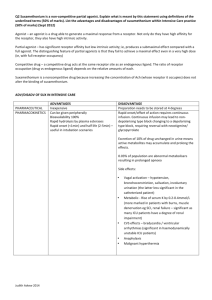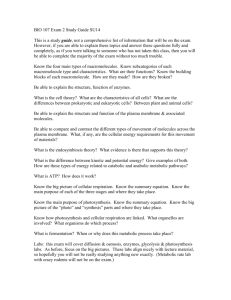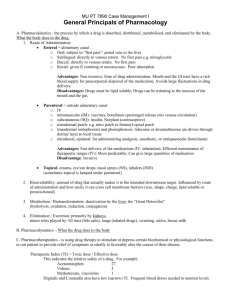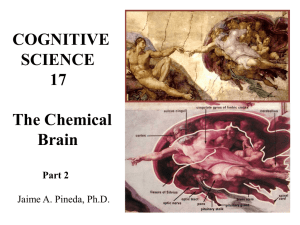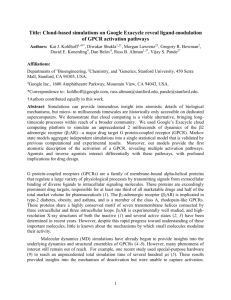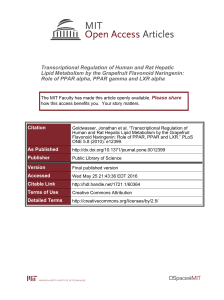Review Assessment: Pharmacology Exam 1 Question 1 0 out of 2.5
advertisement
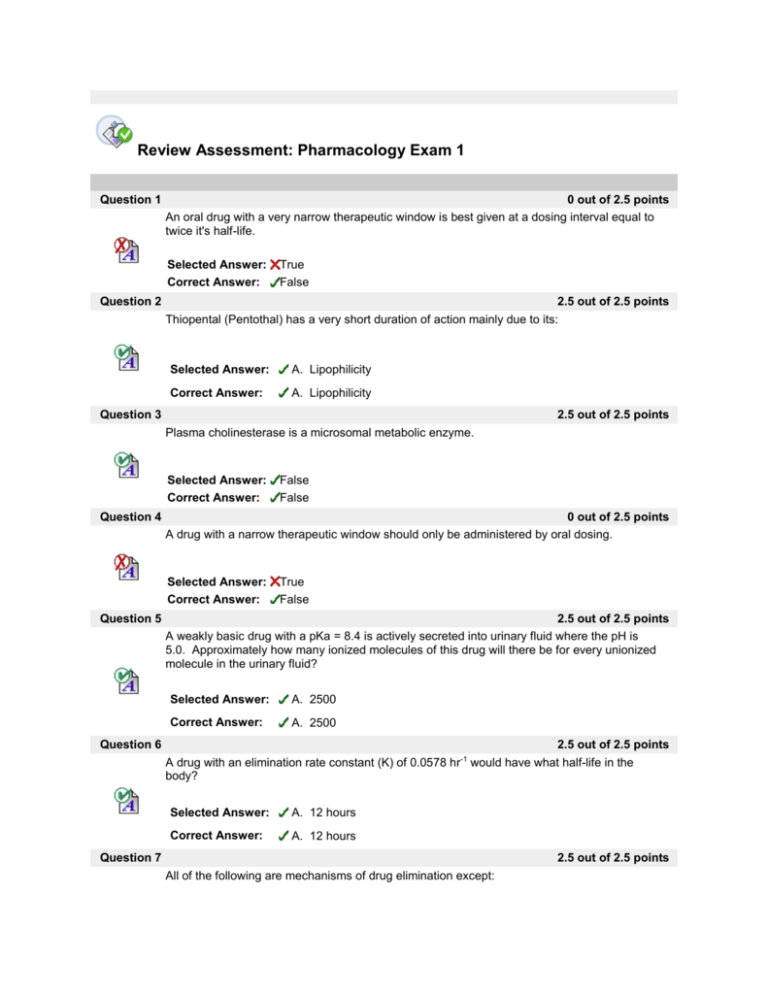
Review Assessment: Pharmacology Exam 1 Question 1 0 out of 2.5 points An oral drug with a very narrow therapeutic window is best given at a dosing interval equal to twice it's half-life. Selected Answer: Correct Answer: Question 2 True False 2.5 out of 2.5 points Thiopental (Pentothal) has a very short duration of action mainly due to its: Selected Answer: A. Lipophilicity Correct Answer: A. Lipophilicity Question 3 2.5 out of 2.5 points Plasma cholinesterase is a microsomal metabolic enzyme. Selected Answer: Correct Answer: Question 4 0 out of 2.5 points A drug with a narrow therapeutic window should only be administered by oral dosing. Selected Answer: Correct Answer: Question 5 Question 6 False False True False 2.5 out of 2.5 points A weakly basic drug with a pKa = 8.4 is actively secreted into urinary fluid where the pH is 5.0. Approximately how many ionized molecules of this drug will there be for every unionized molecule in the urinary fluid? Selected Answer: A. 2500 Correct Answer: A. 2500 2.5 out of 2.5 points A drug with an elimination rate constant (K) of 0.0578 hr-1 would have what half-life in the body? Selected Answer: A. 12 hours Correct Answer: A. 12 hours Question 7 2.5 out of 2.5 points All of the following are mechanisms of drug elimination except: Selected Answer: E. Redistribution Correct Answer: E. Redistribution Question 8 2.5 out of 2.5 points By definition, a partial antagonist drug is also a partial agonist. Selected Answer: Correct Answer: Question 9 True True 2.5 out of 2.5 points The amino acids cross the blood brain barrier primarily via simple diffusion. Selected Answer: Correct Answer: Question 10 Question 11 Question 12 Question 13 Question 14 False False 2.5 out of 2.5 points The addition of a competitive antagonist to an agonist-containing solution bathing a tissue would: Selected Answer: A. Shift the log dose-response curve of the agonist to the right. Correct Answer: A. Shift the log dose-response curve of the agonist to the right. 2.5 out of 2.5 points In a receptor occupancy curve, the point at which the receptors are 50% occupied is used to obtain the: Selected Answer: C. Dissociation constant Correct Answer: C. Dissociation constant 0 out of 2.5 points A drug with which of the following characteristics will cross the blood brain barrier easiest? Selected Answer: E. A quarternary amine structure. Correct Answer: B. A large partition coefficient ([octanol]/[buffer]). 2.5 out of 2.5 points Patient compliance for repeated oral dosing is best when a drug is to be given: Selected Answer: C. Once a day Correct Answer: C. Once a day 2.5 out of 2.5 points The amount of action a drug molecule elicits at it's receptor is referred to as the drugs: Selected Answer: E. Intrinsic activity Correct Answer: E. Intrinsic activity Question 15 2.5 out of 2.5 points A purely competitive antagonist would be classified as having: Question 16 Question 17 Selected Answer: B. Good affinity but no intrinsic activity. Correct Answer: B. Good affinity but no intrinsic activity. 0 out of 2.5 points If an unknown drug is given prior to an agonist drug, and the log(dose) vs response curve is shifted left compared to the curve of the agonist alone, we can say that the unknown drug is demonstrating: Selected Answer: C. Non-competitive antagonism Correct Answer: B. Allosteric potentiation 0 out of 2.5 points The CYP3A4 enzymes are responsible for the largest percentage of phase I metabolism of drugs. Selected Answer: Correct Answer: Question 18 False True 0 out of 2.5 points N-acetylcysteine (Mucomyst) is used to restore depleted glucuronide stores in the liver. Selected Answer: Correct Answer: True False Question 19 2.5 out of 2.5 points Elimination of a drug begins once absorbtion of that drug is complete. Selected Answer: Correct Answer: Question 20 Question 21 2.5 out of 2.5 points Considering a zero-order metabolic reaction, which of the following statements would be true? Selected Answer: D. The drug concentration is high enough to saturate the enzymes. Correct Answer: D. The drug concentration is high enough to saturate the enzymes. 0 out of 2.5 points A drug which undergoes extensive enterohepatic recycling will demonstrate a long apparent duration of effect. Selected Answer: Correct Answer: Question 22 False False False True 2.5 out of 2.5 points The glycocalyx layer on the intestinal wall limits absorbtion of extremely lipid soluble drugs. Selected Answer: Correct Answer: Question 23 2.5 out of 2.5 points Metabophoric receptors act to stimulate or inhibit the conversion of one substance into another. Selected Answer: Correct Answer: Question 24 Question 25 Question 27 Question 28 Selected Answer: B. Calcium Correct Answer: C. Potassium 0 out of 2.5 points Sodium-Potassium ATPase transfers 3 sodium ions into the cell while transporting 2 potassium ions out of the cell. True False 2.5 out of 2.5 points The phase I metabolic enzymes in the liver are primarily located in/on the: Selected Answer: A. Endoplasmic reticulum Correct Answer: A. Endoplasmic reticulum 0 out of 2.5 points Which of the following drug elimination routes is not included in the calculation of total body clearance? Selected Answer: B. Renal filtration Correct Answer: D. None of these answers are correct. 2.5 out of 2.5 points Decreasing a maintenance dose of a drug or increasing the time between doses will decrease the plasma concentration of a drug. Selected Answer: Correct Answer: Question 29 True True 0 out of 2.5 points Which of the following ions crossing the axonal membrane during a nerve impulse is responsible for the repolarization of the axonal membrane? Selected Answer: Correct Answer: Question 26 True True True True 2.5 out of 2.5 points Assuming first order kinetics, what IV infusion rate must be used to maintain a steady-state plasma concentration of 50.0 ng/l of a drug if the total body clearance of the drug is 125 ml/min? Question 30 Selected Answer: E. None of these answers are correct. Correct Answer: E. None of these answers are correct. 2.5 out of 2.5 points A urinary acidifier will enhance the renal elimination of a weakly acidic drug that is freely filtered into urinary fluid at the glomerulus. Selected Answer: Correct Answer: Question 31 0 out of 2.5 points Enterohepatic recycling of a drug will decrease the expected half-life of the drug. Selected Answer: Correct Answer: Question 32 Question 33 Question 35 Question 36 True False 2.5 out of 2.5 points Which of the following routes of administration does not require an absorbtion phase for a drug to enter the systemic circulation? Selected Answer: A. None of these answers are correct. Correct Answer: A. None of these answers are correct. 2.5 out of 2.5 points A drug which irreversibly covalently binds to a receptor would show competitive antagonism with the receptor agonist. Selected Answer: Correct Answer: Question 34 False False False False 2.5 out of 2.5 points Which of the following routes of administration are used to minimize peak and trough drug concentrations by maintaining a flat plasma steady-state? Selected Answer: E. Intravenous infusion Correct Answer: E. Intravenous infusion 2.5 out of 2.5 points A compound which utilizes the body's metabolic machinery to produce an active drug molecule would be called a(n): Selected Answer: B. Prodrug Correct Answer: B. Prodrug 2.5 out of 2.5 points Tissue blood flow has little to no effect on the rate at which a drug crosses from the plasma into a tissue. Selected Answer: Correct Answer: False False Question 37 2.5 out of 2.5 points Metabolic reduction of a nitro group on a drug molecule produces a primary amine. Selected Answer: Correct Answer: Question 38 2.5 out of 2.5 points Adjacent muscle cells can allow ions to flow between each other via gap junctions. Selected Answer: Correct Answer: Question 39 True True True True 2.5 out of 2.5 points Water-soluble drugs with molecular weights above 60 amu can not cross membranes through cellular pores. Selected Answer: Correct Answer: False False Question 40 2.5 out of 2.5 points Which of the following is not an example of a phase I metabolic process? Selected Answer: C. Sulfate conjugation Correct Answer: C. Sulfate conjugation
